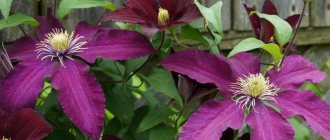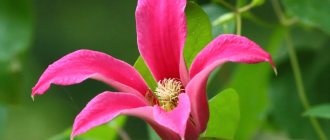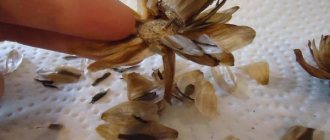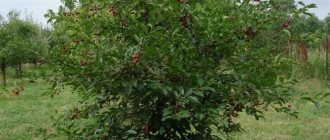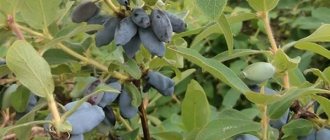Description and characteristics of clematis President
The bush of the beautifully flowering variety President is medium-sized, develops up to 2-2.5 m, sometimes over 3 m. The roots of the vine spread 90-100 cm in diameter. The vines of hybrid clematis ze President are equipped with special shoots - tendrils, with the help of which they rise along the support, clinging to small parts of protrusions or trunks.
The leaves are ovate, elongated, up to 10 cm, with a pointed tip. Shoots grow quickly, up to 5-9 cm per day. During the first season, a seedling produces 3-5 new shoots. The President variety, planted according to the rules of agricultural technology, blooms profusely and for a long time with good care.
Clematis blooms first in late May or June on overwintered stems left after last year's or spring pruning. The open buds of clematis President on long peduncles form large star-shaped flowers of an intense purple tone, with a diameter of 13-18 cm. In 6-8 sepals, the longitudinal central stripe is distinguished by purple tints, the edges are slightly wavy.
The middle, or “spider,” as flower growers call the central part of an open clematis bud, contrasts with the main bright tone - white at the base and burgundy at the tips. The second wave of clematis flowering The President decorates the vine in August-September. Autumn flowers can be slightly smaller, up to 10-14 cm in diameter.
The culture lives in one place for quite a long time, up to 30 years. The plant tolerates short-term frosts - 28 ° C, and requires shelter for the winter in the middle zone. The President variety liana will decorate the walls of buildings, fences, and decorate the trunk of an old tree with an openwork crown.
In the north, the variety is grown in containers, in cities - on balconies, providing a tub volume of 15 liters and with regular fertilizing and watering. Clematis President will form a real flower waterfall if the requirements for the culture are met:
- planting in a bright, wind-protected place;
- in the middle zone the plant will be comfortable in sunny exposure, and in the south it is placed so that the clematis is shaded at midday;
- ensuring sufficient soil moisture;
- in the south - preserving the root system from overheating by mulching or planting ground covers;
- preserving the stems in winter under reliable shelter.
Advice! The President variety of clematis is considered very decorative, ceremonial, and the plant is planted in the most prominent places.
Flowers
The color of the flowers of “President” is unusual: the color intensity changes from the outer edge of the petals to the center. Typically the edges are a rich dark purple while the middle is much lighter, maybe even blue. In addition, a silver stripe often runs down the center of the petal. Light anthers with dark red tips make the flower especially expressive.
Not only “President” has interesting flower colors. In many varieties of clematis, the shade of the petals is brighter at the beginning of flowering, and towards the end it seems to “burn out”. The flowers of other vines change color when growing conditions change, such as increased soil moisture or acidity.
The shape of the flower resembles a star with 8 petal rays. The flower size can reach 15 cm in diameter. The petals have wavy edges, they are elongated in shape, pointed at the ends.
Interesting! The flowers are shaped like a star, the edges of the petals are wavy.
Clematis blooms profusely, twice a season. The first wave of flowering forms on the overwintered shoots of the previous year, so you can see the first flowers on plants quite early - already in May. The second stage is provided by young shoots of the current year; flowering on them begins in July and lasts until September or the first frost.
History of selection
Clematis variety President was bred by English breeders in the 19th century. But even among the many varieties of these plants, the variety is in demand to this day.
The flower received its name in honor of the president of the Royal Botanical Society, where it was first bred.
Endurance
Clematis in general are famous for their hardiness and unpretentiousness. According to numerous reviews, clematis “President” is no exception. In central Russia, it tolerates even significant temperature drops without problems (for example, frosts down to –34 ℃). The plant is also grown in the Urals and Siberia, but with a lack of sun, flowering periods may shift and shorten. In these regions, even in snowy winter conditions, the bush must be covered for the winter.
Reviews from flower growers
Tamara, 36 years old, Tula When I decided to plant clematis in my garden plot, everyone dissuaded me. Like, you'll be tired of looking after them. But there are no problems with the President variety. It has taken root well and has already sprouted several shoots in the spring. Now this is my pride, which surprises guests all summer with lush flowers.
Olga, 41 years old, Voronezh The sapling was given by her husband. He also helped plant it. Arranged the bars. Now in the summer we drink tea in the shade of the luxurious clematis variety President. It grew very quickly. One of the difficulties in care is to close it for the winter and prune it in the summer and autumn. But I got rid of the need to plant a bunch of annual flowers. There is a lot more fuss with them.
Application in landscape design
You can use clematis to decorate your site in different ways.
You can make an arch right at the entrance to your personal plot. In this case, everyone will be able to admire such beauty.
The area will look beautiful if clematis and roses are planted together. This approach to design is considered traditional among the British. Climbing roses are most often used, which, in addition to their intended purpose, also act as a support for vines.
To summarize, we can say that clematis “President” is excellent for growing in personal plots, as well as for decorating city parks and gardens, because it can be combined with different plants. Its unusually beautiful large flowers will not leave anyone indifferent.
Source
For information on how to properly care for clematis “President”, see the following video
Main characteristics
Let's summarize some data in a table:
| Parameter | Characteristic |
| Genus | Clematis or Clematis |
| Growth form | bush liana |
| Type | Large-flowered |
| Group | Patens |
| Flowering period | May–June, re-blooming in July–September |
| Flowering type | On the shoots of last year, on the young shoots of the current year |
| Possibility of re-blooming | Yes |
| Flower color, structure | Blue-violet, not terry |
| Flower size | About 15 cm |
| Plant height | About 2m |
| Frost resistance | High (can withstand temperatures down to -34 ℃) |
| Life cycle | Perennial |
| Trimming group | 2 (partial trimming required) |
| Purpose | Vertical gardening, decor |
| Sustainability | Does not tolerate stagnant water and overheating of the soil. Moderately affected by fungal diseases and pests |
| Inclusion in the State Register of the Russian Federation | Turned off |
Features of planting clematis President
Beautifully flowering clematis is planted from the third decade of August until the end of September or in the spring, when the buds are just beginning to develop.
Deadlines
Planting flowering vines in open ground depends on the climatic characteristics of the region. In temperate and southern latitudes, the flower is planted at any time from spring to late autumn. But, according to experienced gardeners and flower growers, the best time to plant flowers is still autumn.
Selection of seedlings
When purchasing clematis President in the fall, pay attention to the good condition of the vine, fresh leaves, they should be free of damage and stains. In spring, swollen or already half-opened buds should be clearly visible on the stems.
President variety seedlings with an open root system are transported to the planting site with roots wrapped in damp cloth. High-quality specimens of clematis have fibrous roots, at least 3-5 long shoots up to 25-30 cm. Seedlings from nurseries that are sold in pots are immersed in a large container of water. Afterwards, the entire earthen lump easily comes out of the container.
Site preparation
All large-flowered vines, like clematis of the President variety, have conditions under which they develop well:
- place them in the sun and in openwork shade;
- the tree trunk circle should always be saturated with moisture, and in hot periods protected from overheating;
- a site is selected with drained soil;
- the soil is loose, not compacted, fertile, with a neutral or slightly alkaline acid reaction;
- an artificial mound up to 40-60 cm high is poured in the lowland, and a planting hole is dug inside it;
- The peculiarity of decorative vines is that they bloom beautifully in a place protected from the wind.
Important! On acidic soils, dolomite flour and wood ash are mixed into garden soil.
Landing scheme and rules
When placing clematis The President near fences, buildings, trees, set aside at least 50-70 cm so that the roots can develop freely, and at the same time do not suffer from the falling flow of water during rain. The same distance is maintained between individual bushes. The depth of the hole depends on the soil. If its indicators meet the agrotechnical conditions of the crop, 40 cm is enough. If the soil is completely changed and a high drainage layer is necessary, they dig deeper. Diameter – up to 60 cm.
Having dug a hole, install a support, and then plant clematis President:
- Having freed the roots from the container, carefully straighten the overly protruding shoots and sprinkle them with soil;
- make sure that not only the root collar is under the ground, but also the lowest bud is deepened to 8-12 cm.
In spring, the hole is not filled to the surface level, a depression is left, thanks to this technique the shoots develop faster. After autumn planting, the soil is compared, but then in April-May, part of the soil is removed from the tree trunk circle. When new shoots grow, their bases are sprinkled with loose soil.
Reproduction methods
Clematis variety President is propagated by cuttings or layering. But only if it is already growing on your site.
Most often, planting material is purchased in the store. It is advisable to buy seedlings from a trusted seller. When purchasing, please note that a healthy and strong clematis seedling of the President variety has one or two shoots with living buds and well-developed roots without damage, the length of which is at least 30 cm. This particular seedling will not cause any trouble when planting the President clematis and subsequent care.
Caring for clematis President
An unpretentious plant requires only minimal care.
Watering and loosening
The moisture-loving clematis grandiflora President pleases with an abundance of buds with regular watering once a week, 1-2 buckets. During hot weather, water every 2-3 days with the same volume around the perimeter of the tree trunk. For an adult bush, 30-40 liters are required per single watering so that the soil is moistened to the entire depth of the roots.
When sprinkling, do not direct the stream at the base of the clematis. The next day after watering, the soil is loosened. A good option is mulching with dry grass and compacted sawdust. If clematis President is planted in the sun, low, up to 50 cm, flowers or a ground cover bush are placed on the south side, which will shade the base of the vine and protect the roots from overheating.
Top dressing
A beautifully flowering plant is fed 3 times:
- in May, clematis are fertilized with any nitrogen preparation, adding organo-mineral products, like “Ideal”;
- at the beginning of flowering, use any complex fertilizers for flowers or potassium humate;
- in August, potassium sulfate and superphosphate are used.
The most beautiful clematis of the third pruning group
These clematis varieties of pruning group 3 do not require any introduction; they can be recognized only by looking at the photo. The most beautiful and popular views.
Elegy
The variety is used to decorate gazebos because it grows quickly. The height is 3 m. There are many flowers on the vines. They are large, 13–15 cm in size. The color is blue-violet, which fades in the sun over time and becomes less bright. There is a purple stripe running down the center. The time of appearance of buds falls in July and ends with the arrival of autumn.
Victoria
The variety is characterized by large flowers up to 20 cm in diameter. The unusual color makes clematis stand out from other plants. The color is pink-red, with a contrasting stripe. Anthers yellow. The bulk of the inflorescences are concentrated in the upper part of the shoots. Blooms luxuriantly in July–September.
Nikolay Rubtsov
Clematis of the third pruning group grows up to 3 m. The blossomed bud acquires a purple hue, its size is 16 cm. There is a stripe in the middle. The edges are wavy. The core is yellow. The flowering period consists of two stages: the first begins in July, but after a month it withers due to the heat, the second - August - September, but less abundant.
Ernest Markham
Clematis is rightfully classified as one of the best varieties of pruning group 3. It has a rich, bright red color of the inflorescences. It grows slowly, blooms in July, but is very lush. Lianas are easily attached to natural supports and arches.
Important! Winters well, but requires thorough pruning.
Diseases and pests
The roots, stems and leaves of clematis often become sick, infected with fungi or viruses. Diseases are prevented by preventive spring treatment with copper-containing preparations, which also affect pest larvae. If the soil in the area is acidic, the tree trunk circle is alkalized by pouring a solution of 200 g of dolomite flour or 100 g of lime in 10 liters of water in early spring. Having noticed the withering of the stems and yellowing of the leaves, the diseased shoots are removed. For treatment, use the drug “Trichoflor”, using according to the instructions. A soap or soda solution destroys aphid colonies. Clematis is sprayed with insecticides against leaf-eating insects.
Wilt
This is a fungal infection, the most important enemy for clematis President. It occurs from an excess of moisture in the soil and air. The plant quickly withers, turns black and dies. To avoid damage to flowers by Verticillium wilt, it is recommended to spray the bushes in the spring with special preparations based on fungicides.
Gray rot
Gray mold spreads in moist, cool environments. Gray, fluffy spots appear on the leaves of the vine. The plant quickly withers and dries out. The fungus spreads quickly by air, so at the first symptoms, the bushes are treated with fungicides.
Powdery mildew
With prolonged heat and heat, plants are affected by powdery mildew. To prevent the disease, folk recipes or preparations based on the same fungicides are used.
Rust
If yellow swellings with small particles appear on the clematis, it means that the plant is at risk of rust infection. The disease quickly destroys the leaf cover and poses a threat to the growth and development of shoots.
In order to combat fungal diseases, copper-based preparations are used.
Nematodes
Nematodes parasitize the entire plant, from the rhizome to the leaf cover. Unfortunately, no effective drugs have yet been invented to combat this pest. Therefore, as a preventive measure, the roots of suspicious plants are treated with very hot water (+50 degrees), and calendula or dill are planted nearby. Nematodes do not tolerate these crops and disappear.
Important! At the site where nematode-infected plants grew, the soil is disinfected. It is prohibited to plant flowering vines in this area for 3-5 years.
Rodents
In winter, rodents can damage the plant. To prevent the death of flowers, poisoned traps and bait are placed next to them.
Aphid
To prevent the appearance of aphids, every spring I treat the plants with preparations based on fungicides. When a vine is infected with this pest, the bushes are sprayed with special solutions with the addition of insecticides.
Source
Description of the variety
Clematis with the interesting name “Taiga” was bred by breeders relatively recently. The variety is large-flowered and attracts gardeners with its amazing appearance. “Taiga” blooms almost from the beginning of June until the beginning of September. The bush reaches a height of 2 to 2.5 meters, and its width ranges from 70 centimeters to a meter. The color of the flowers of the climbing perennial is a combination of blue and purple with a slight addition of pink.
In this case, the tips of the petals are most often colored green-yellow, and sometimes lemon-colored. The diameter of one flower can reach a range from 13 to 15 centimeters, which is quite a high figure. In principle, proper care and compliance with planting rules helps to achieve a larger size. The leaves of this clematis are painted in a beautiful green shade and are characterized by the presence of a neat edge. Their shape can be heart-shaped or trifoliate, thanks to the combination of several individual leaves in the form of a pointed ellipse.
Thus, the crop is recommended for growth in 9 climatic zones. If we compare “Taiga” with other clematis, its clear advantage will be the presence of beautiful double-shaped flowers. Over time, an ordinary flower transforms into a densely double one, which prolongs the flowering process. The shade of the buds also changes at this time. Clematis "Taiga" is not afraid of not only low temperatures, but also unfavorable conditions. However, it reacts very poorly to shady areas - the lack of sun leads to slower growth and development of the plant.
The best photos of clematis President
Planting and care
To grow a garden crop that blooms from May to September, it is necessary to carry out timely and correct work on planting seedlings in open ground.
Selecting a location
The correct choice of place for planting flowers will ensure active development and abundant flowering of clematis.
- For planting, choose sunny, dry areas at low elevations.
- Garden culture does not tolerate strong winds and drafts.
- If there are close deposits of groundwater on the site, then the place for planting flowers must be raised by 15-20 cm. Otherwise, the plants are exposed to excessive moisture, which will lead to the development of fungal diseases and rotting of the rhizomes.
- Plants planted close to buildings also suffer from excess moisture that enters the soil from the roof.
Advice! To protect the root system of clematis President from severe overheating, annual flowers are planted around the bushes, which shade the plant .
Soil preparation
The composition of the soil determines the growth and flowering of garden crops. Therefore, clematis are planted in previously prepared fertile, loose soil with a low acid content. Peat, sand and mineral fertilizers are added to well-loosened soil. Soil preparation is carried out in advance, 2-3 weeks before planting.
Selection of planting material
If the planting material is grown independently, then before planting in open ground, the rhizomes are disinfected with special means.
But when buying seedlings, first of all they examine the root system of the plant. It should be free of damage, putrefactive deposits, compactions and not overdried. There should be 2-4 vegetative buds on the shoots. The acceptable size of the above-ground part of the seedling is from 30 cm, with smooth shoots without damage and manifestations of diseases and pests.
Before planting, the seedlings are immersed in settled water for 30-60 minutes, then treated with antibacterial agents or a weak solution of manganese.
Planting scheme
Flowering vine is a tall and spreading plant. When planting seedlings, leave at least 1.5 m of free space between plants.
- In a prepared area or flower bed, dig holes ranging from 60 to 90 cm in depth and the same size in diameter.
- High pegs are installed in the holes to support the plant.
- A layer of stones or crushed stone is placed in the hole. This procedure will prevent moisture from stagnating in the soil.
- Next, a small pile of fertile soil is poured onto which the seedling is placed.
- The rhizomes are carefully laid out in the hole, sprinkled with soil and watered thoroughly.
See also
Methods for propagating clematis by seeds, planting and growing at homeRead
Important! When planting in open ground, the root collar of clematis is buried 8-10 cm from the top soil level .
Deadlines
Planting flowering vines in open ground depends on the climatic characteristics of the region. In temperate and southern latitudes, the flower is planted at any time from spring to late autumn. But, according to experienced gardeners and flower growers, the best time to plant flowers is still autumn.
Watering
Maintaining optimal soil moisture is a key point in growing clematis. It is very important to monitor the condition of the soil after wintering. For example, when there is little rainfall in the spring, watering is necessary to saturate the roots with moisture. Further, before the onset of summer heat, artificial humidification is usually not required.
READ MORE: Kitchen-living room in Provence style 36 photos combined layout of a cozy room and its interior design in Provence style
At least 1-2 times a week, 1-4 buckets of water are applied to the root. It is necessary to carry out procedures in the evening to ensure slow evaporation of moisture. The water is preheated in the sun.
Preparing for landing
Large-flowered clematis can grow in one place for more than 30 years. Provided the fit is correct.
Clematis has a powerful root system that can extend 1 m both deep and wide into the soil. Before planting, pits are specially prepared. The optimal size is 60x60x60 centimeters or a little more. It is mandatory to lay a drainage layer of crushed bricks or stones. Its layer should be at least 10 cm.
It is advisable to place leaf humus or rotted manure on top of the drainage. Next, the hole is filled with prepared fertile soil.
The ideal option is to prepare the hole a month before planting the plant. In this case, the earth will settle and ideal conditions for rooting will be created.
Clematis bush Ville de Lyon
Despite its general cold resistance, Piilu clematis still requires preparation for wintering. To carry it out, it is recommended to choose a dry day with a temperature of about 0 degrees. First, the plant is completely freed from foliage, then it is subjected to sanitary pruning, removing dead and dry branches. If necessary, crown formation is performed.
In the dry autumn period, in preparation for winter, it is worth watering by adding 1 bucket of water under the clematis root. Next, the root collar is covered with wood ash powder, and the bush is sprayed with a solution of copper sulfate. Dry humus or compost in a volume of 10-12 liters is added under the base of the trunk to protect against freezing.
In cold climate zones, the surface part of the plant is additionally covered. Sand is poured onto the compost placed under the root, and the lashes removed from the support are tied with twine. Clematis prepared in this way are bent to the surface of the soil, covered with spruce branches, fallen dry leaves, and soil is poured on top with a layer of at least 25 cm.
READ MORE: Open external and internal electrical wiring
